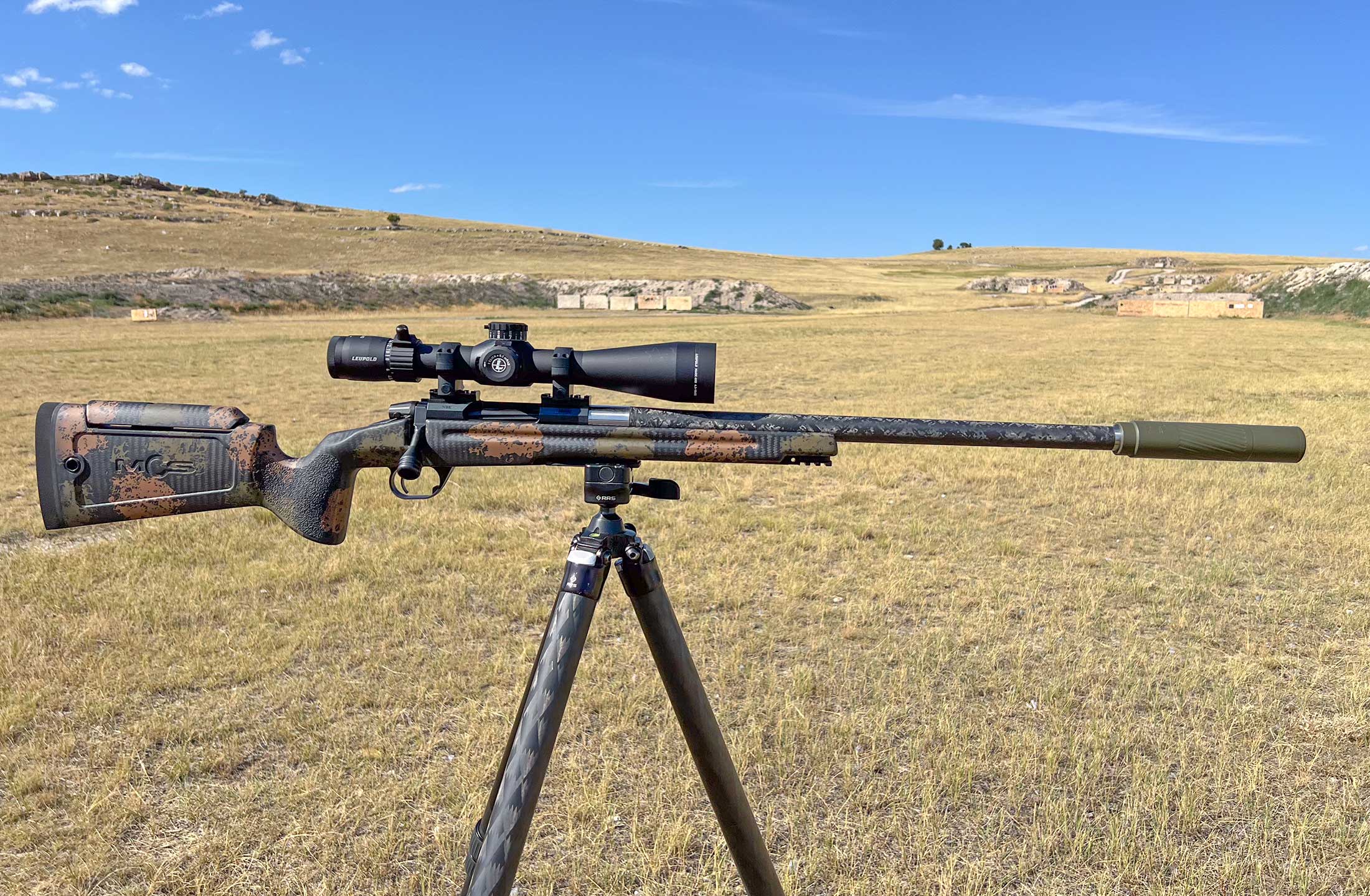Best Rimfire Scopes of 2025, Tested and Reviewed
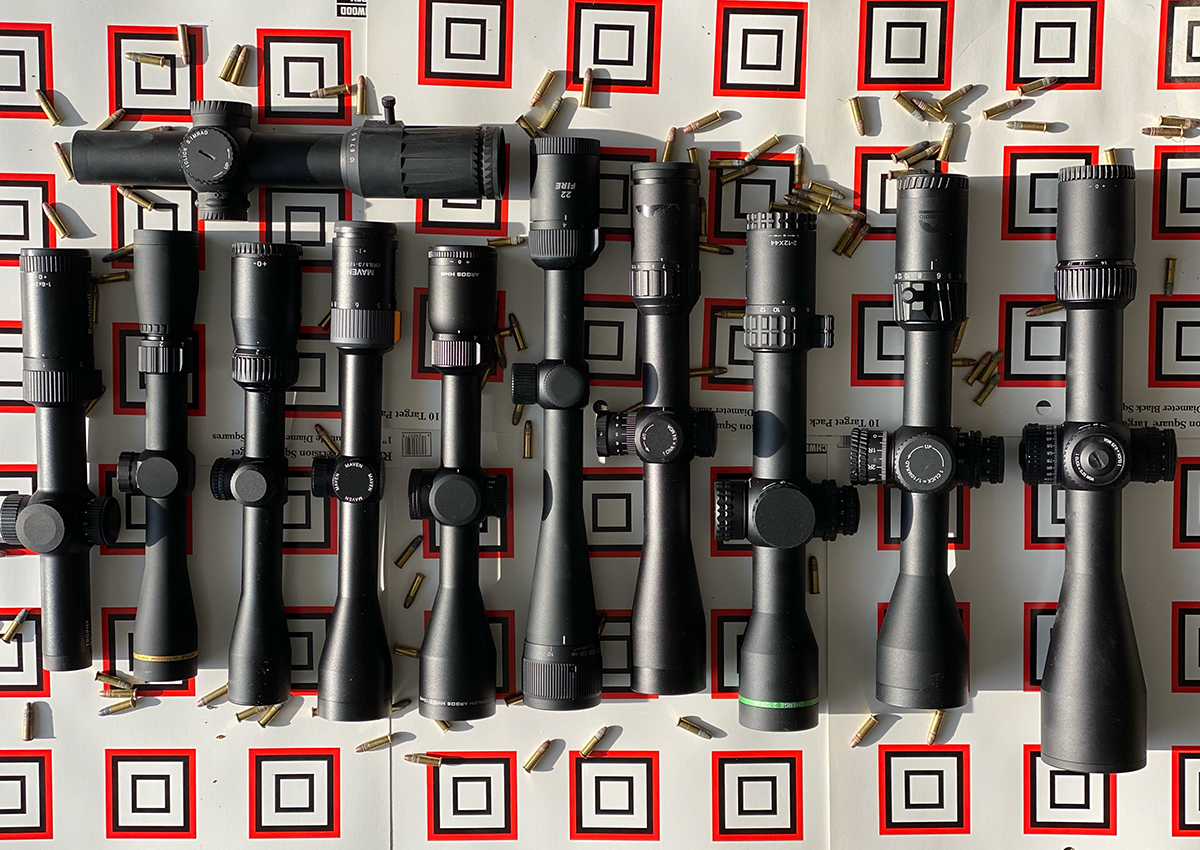
We may earn revenue from the products available on this page and participate in affiliate programs. Learn More ›
Between small-game rifles and precision target rigs, short-range plinkers, and rimfire ARs, there’s a .22 for every shooter and use, and every one of them needs a scope. The optics industry has answered the call, and you can find a scope for just about any rifle. Here are some of the best rimfire scopes on the market. You’ll notice, though, that these aren’t all your standard low-mag variable models. You’ll see some high-end precision scopes here as well as LPVO (low-power variable optics) that are designed for close-quarters AR and shotgun work but also make marvelous rimfire optics for either hunting or punching targets.
How I Chose the Best Rimfire Scopes
Some of the scopes in this roundup are new for 2022 and were included in the rigorous evaluations of Outdoor Life’s annual optics test. For those, I measured optical resolution on my resolution range, scored low-light performance against their peers, and measured the precision and repeatability of the reticle and turrets. But some scopes in this collection were not in the test, and I evaluated those by mounting them to my collection of .22 trainers and shot them on both paper and steel targets at various distances, evaluating their handling, reticles, and overall precision and speed.
I rated each scope on its ability to perform a series of shooting tasks, engaging targets at 20 yards, then at 50, and out to 100. I also used both reticle references and the turrets to make shots out to 350 yards, but this was more a test of “close-enough” than precision.
For each scope, I make a subjective determination of optical quality, looking for distortions, optical aberrations, and any distracting jags of light. And I determine how quickly and precisely I can use the reticle. Lastly, I assessed the extras, including the accessories that it ships with and each submission’s warranty.
The Best Rimfire Scopes: Reviews and Recommendations
Best Overall: Leupold VX-Freedom 2-7×33
See It
Pros
- Excellent glass and coatings
- MOA-based references are simple and clear
- Low-profile mounting dimension
- Wide versatility
- Catchy turret graphics
Cons
- Reticle lacks windage references
- Parallax fixed at 100 yards
- Turret clicks are mushy
Key Features
-
Weight:
11.1 ounces -
Magnification Range:
2-7-power -
Objective Lens Diameter:
33mm -
Tube Diameter:
1-inch -
Turret Click Values:
.25 MOA -
Total Elevation Adjustment:
75 MOA -
Reticle Focal Plane:
Second -
Illuminated Reticle:
No
Combining simple controls and a modest but versatile magnification range, this durable scope is perfect for just about any .22 or .17, whether for small-game hunting, plinking, or most precision target work. It has good glass, repeatable controls, and enough holdover references on the vertical stadia that, with some practice, you can extend your range out to 100 yards and longer. At close to $300, it’s priced in the meaty middle of the market and can easily transition from a first-gun optic to just about any other rifle, whether a rimfire or not.
Here’s a rimfire scope for just about any purpose. This outwardly pedestrian optic has a lot going on between a surprisingly precise second-plane reticle, bright glass, and fun indexing on the nicely tactile turrets. The best thing you can say about any scope is that it is consistent, and the VX-Freedom delivers bullets with pleasing reliability. It’s a good rabbit and squirrel scope. Still, the MOA-based references on the vertical crosshair make it a decent option for engaging distant targets, which means you don’t have to invest in a ponderously big first-plane target scope to take titles at NRL22 competitions. Lastly, the Leupold rimfire scope brings the company’s good glass and an excellent warranty.
Read Next: The Best Rifle Scopes
Best Price-Point: Burris Fullfield
Photo by Andrew McKean 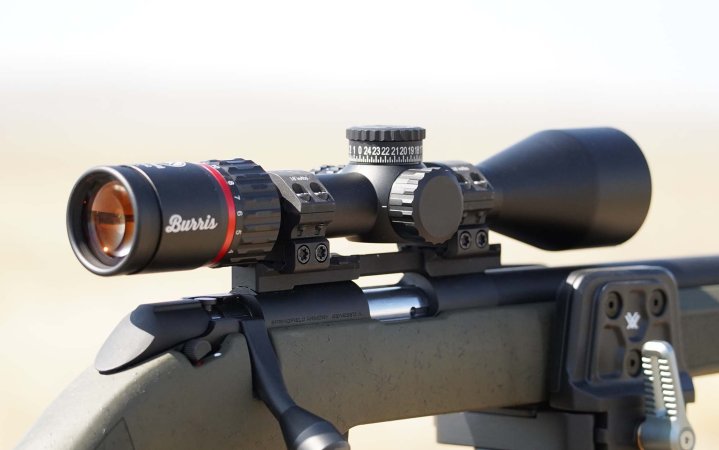
Buy From Optics Planet
Buy From EuroOptic
Pros
- Wide range of reticles
- Available in either illuminated or non-illuminated versions
- Accessible price
- Lifetime transferable warranty
- Handsome styling
- Knob Synergy System enables turret interchangeability
Cons
- Forgettable glass
- Parallax adjustment limited to higher-mag models
- Limited mounting dimensions
Key Features
-
Available with capped or exposed turrets -
Second-plane reticles -
Custom turrets available for every model -
4-times zoom ratio -
Available in wide range of configurations and reticles -
Available in both illuminated and non-illuminated models -
Turret adjustments in ¼ MOA click values -
2-8×35 version weighs 14 ounces (illuminated model) -
Liberal eye relief -
Price:
$160 to $600
Whether you opt for the 2-8×35, the 2.5-10×42, or the 3-12×42, the redesigned Burris Fullfield offers a ton of value and performance for a modest price. The performance is high enough that it’s not quite right to call this classic an entry-level scope, but the price makes it accessible for just about any new shooter, and just about any rimfire or straight-wall rig.
Of course, the iconic Fullfield has been around for a spell. Its first iteration came to market in 1975 as Don Burris’s answer to Redfield’s Widefield scope. Burris had worked at Redfield before starting his own optics company in Denver. The new iteration of the scope, 50 years later, retains some of its predecessor’s features, including wide field of view, double-spring erector system in its turrets, 1-inch tube, and second-plane reticles.
But it has some noteworthy new attributes, starting with what Burris calls its Knob Synergy System. Elevation dials on new Fullfield scopes are almost universally interchangeable, allowing users to switch out the capped turrets of their original model for what Burris calls its “Advanced Capped” and “Advanced Exposed” elevation knobs along with custom laser-engraved knobs. This is a pretty remarkable attribute for scopes that range in price from $192 for the 2-8x35mm model to $300 for the 3-12×42 model.
It’s useful to note that the new Fullfield is available in 3-12×56, 4-16×50, and 6-24×50 iterations. All but the 6-24×50 scope is available with or without illumination.
But for rimfires, it’s hard to beat the lower-mag models for all around plinking, small-game hunting, and on straight-wall rifles, just about any deer hunting scenario you can imagine. The 2-8×35 model has liberal eye relief (2.9 to 3.4 inches), good field of view, and the choice of either Burris’s excellent Ballistic E3 reticle in the illuminated version and standard plex reticle in the non-illuminated version.
The 2.5-10×42 version offers all those features, plus a little more reach.
I strapped my test model on a precision rimfire and have been using it for ground-squirrel removal for the past month. Its glass is good, but about what you’d expect for a $200 scope. It’s a little flinty in harsh light, a little distorted on the edges, and a little dark at last light. But I’ll take that. The center is well-ground and crisp, and the BDC reticle – mine has the Ballistic E3 – is perfect for longer shots but doesn’t impede those close-in snap shots that every rimfire hunter is familiar with.
At the end of the day (or the beginning of it, for that matter) I don’t buy a rimfire scope for its premium glass. I select for fast handling, low-profile mounting, and a liberal eyebox. The Fullfield delivers all that, plus the ability to swap out turrets is an appealing add-on. I want a little more mounting dimensions on the tube, but the fixed focus at 100 yards is spot-on for shots inside 25 yards and out to about 150 yards. For a rimfire, that’s about the range I want.
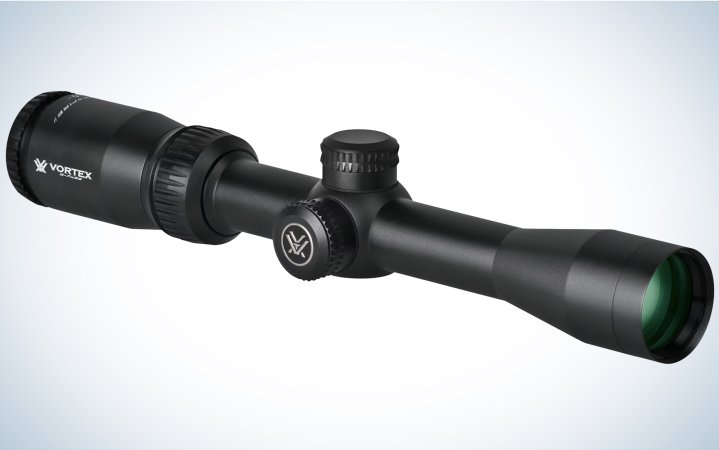
See It
Pros
- Long eye relief
- Appealing price
- Low-profile mounting dimensions
- Simple reticle
- Excellent warranty
- Parallax fixed at 50 yards
Cons
- Reticle lacks windage or elevation references
- Limited focus control
Key Features
-
Weight:
13.9 ounces -
Magnification Range:
2-7-power -
Objective Lens Diameter:
32mm -
Tube Diameter:
1-inch -
Turret Click Values:
.25 MOA -
Total Elevation Adjustment:
60 MOA -
Reticle Focal Plane:
Second -
Illuminated Reticle:
No
There’s not much innovative or surprising here, just a basic duplex reticle inside a straight-ahead scope with decent turrets and a durable build. Backed by an excellent warranty.
If simplicity is the pathway to versatility, then the Vortex Crossfire II is at home on a small-game bolt rifle or a fast-shooting AR. It might not have the chops for precision work, but the duplex reticle is fast and reliable. The controls are a little mushy, but the eye relief and eye box are both forgiving and the fixed parallax makes it a great plinking scope. Basically, any tin can or cottontail inside 50 yards is in trouble.
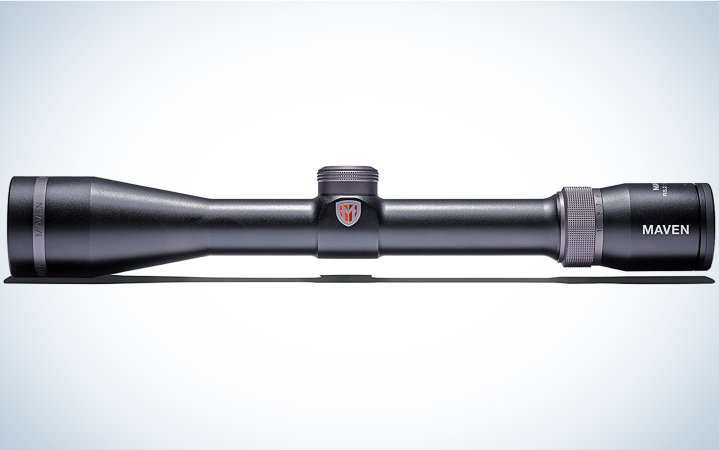
See It
Pros
- Light and compact
- SHR reticle has (limited) elevation references
- Utility extends to center-fire scopes
- Liberal mounting dimensions
- Excellent glass and coatings
Cons
- No windage references
- Slightly spongy turret dials
Key Features
-
Weight:
12.4 ounces -
Magnification Range:
2-10-power -
Objective Lens Diameter:
38mm -
Tube Diameter:
1-inch -
Turret Click Values:
.25 MOA -
Total Elevation Adjustment:
50 MOA -
Reticle Focal Plane:
Second -
Illuminated Reticle:
No
Excellent glass, velvety controls, and a reticle that offers just enough holdover references for precision work, this is a scope that’s at home on a lightweight mountain rifle or a bespoke squirrel sniper. The RS.2 is available in either a bold duplex or SHR reticle—I recommend the latter for more references (three elevation holds; no wind holds). That probably has more utility for big-game hunters than for .22 shooters, but the holdovers are pretty handy for making shots beyond zero range.
At about $550, this direct-to-consumer optic is a little pricey for a basic second-plane rimfire scope, but Maven brings elegance, brilliant Japanese glass, and sweet turret controls to the game. The low-profile objective and the magnification range make it a very good choice for a special rimfire rifle.
Read Next: The Best .22 LR Rifles
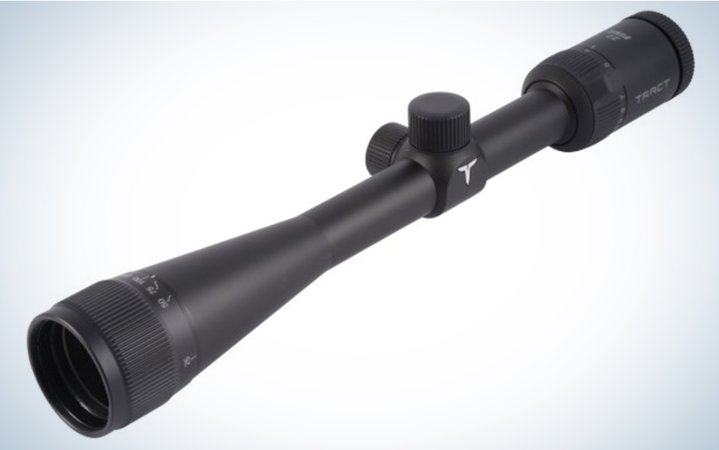
See It
Pros
- Excellent focus control, 10 meters to infinity
- Extremely tactile turret controls
- Long eye relief
- Liberal mounting dimensions
Cons
- Focus on objective is clunky
- Extremely tight power ring
Key Features
-
Weight:
16 ounces -
Magnification Range:
4-12-power -
Objective Lens Diameter:
40mm -
Tube Diameter:
1 inch -
Turret Click Values:
.25 MOA -
Total Elevation Adjustment:
60 MOA -
Reticle Focal Plane:
Second -
Illuminated Reticle:
No
Tract’s 22 FIRE series has a full series of scopes for .22 and .17 shooters, but this AO model (it stands for Adjustable Objective) is the most versatile scope in the line from the direct-to-consumer brand. The duplex reticle features a fine crosshair with a .25 MOA center dot, which allows for full view of the target and precise bullet placement, which competitive bullseye target shooters will appreciate.
The adjustable objective enables precise focus for targets inside 10 yards all the way out to infinity, a feature you don’t often see on rimfire-specific scopes. The objective focus is a little clunky compared with the side parallax of most modern scopes, but it works well and further enables precise shooting. At about $275 it’s not a cheap scope, but the glass is good, the controls are some of the best in the business, and the precision it allows also makes it a killer squirrel scope.

See It
Pros
- Versatile magnification range
- Illuminated reticle
- Side focus
- Capped turrets
- Good warranty
Cons
- Underwhelming glass
- Controls are mushy
- Limited mounting dimensions
Key Features
-
Weight:
19.8 ounces -
Magnification Range:
2-12-power -
Objective Lens Diameter:
42mm -
Tube Diameter:
1-inch -
Turret Click Values:
.25 MOA -
Total Elevation Adjustment:
130 MOA -
Reticle Focal Plane:
Second -
Illuminated Reticle:
Yes
This second-plane middle-of-the-road scope isn’t built for any specific task. Instead, it does a pretty good job at any shooting situation, whether mounted on a center-fire big-game rifle, a rimfire, an AR, or even a mid-range platform like a straight-wall carbine or slug gun.
Priced at about $450, this Athlon has more features than most scopes at this price point. Its best attribute is side parallax control that brings targets as close as 10 yards into sharp focus, a feature that’s useful for rimfire shooters who are often engaging close-in and far-out targets. The illumination is also worth a look. The second-plane scope is available with a standard duplex reticle, but opt for the BDC 600A reticle, which gives shooters holdover hashes out to 600 yards when the scope is on its highest power. The glass in the Argos HMR isn’t the best, but for most shooting situations, it will provide a decent image and capably guide bullets of just about any caliber. The best attribute for a rimfire shooter is that this scope can easily be swapped out to just about any other rifle, making it a good all-around optic.
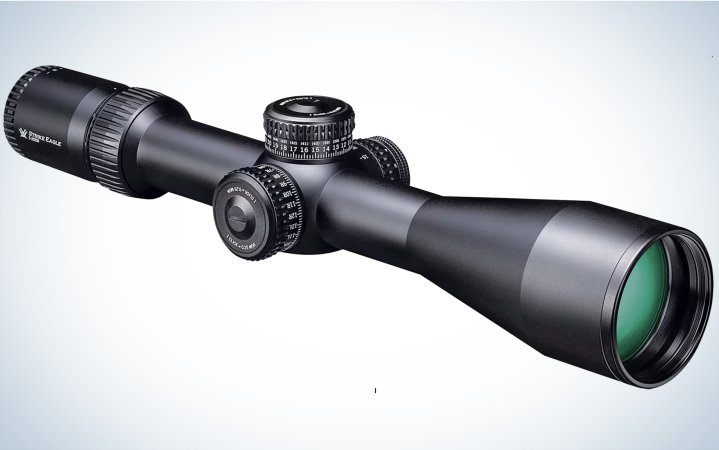
See It
Pros
- Huge magnification range
- Competition reticle
- Side focus, 15 yards to infinity
- Pull-to-turn tactical turrets
- Good warranty
Cons
- Underwhelming glass
- Controls are mushy
- Overkill for most rimfire applications
Key Features
-
Weight:
30.4 ounces -
Magnification Range:
5-25-power -
Objective Lens Diameter:
56mm -
Tube Diameter:
34mm -
Turret Click Values:
.25 MOA -
Total Elevation Adjustment:
110 MOA -
Reticle Focal Plane:
First -
Illuminated Reticle:
Yes
Okay, I realize this isn’t your standard rimfire optic. It’s purpose-built for the 1,000-yard-and-longer center-fire steel-plate crowd. But the Strike Eagle has an extremely useful reticle for almost every rimfire competition, from punching paper at known distances to engaging steel silhouette targets and all the crazy shooting situations in the NRL22. Attributes that make it a worthy rimfire consideration: close-focus to 15 yards, a nicely illuminated first-plane reticle, holdover hashes at every MOA and windage dots out to 24 MOA, and nicely indexed turrets. All this for well under $1,000. The best argument for consideration: learn to shoot this reticle on a cheap and fun rimfire trainer, then graduate up to a center-fire chassis rifle.
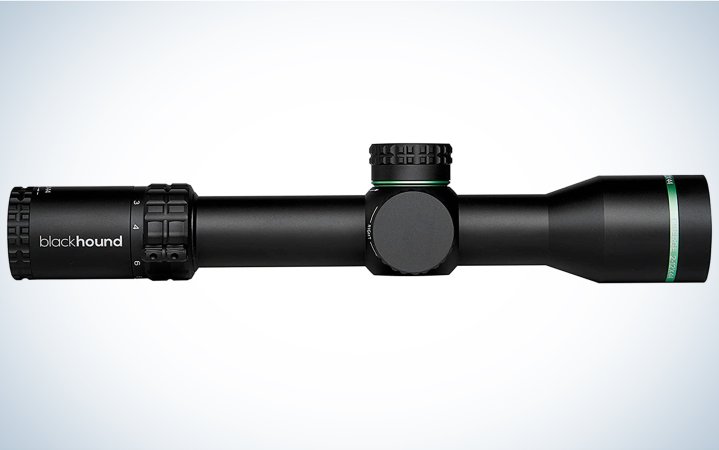
See It
Pros
- First-plane tree-style reticle
- Capped low-profile turrets
- Ships with rings and levels
- Zero stop
- 6-step illumination
- 10 MILs of holdover references
Cons
- Ponderously big
- Fairly expensive
Key Features
-
Weight:
29.1 ounces -
Magnification Range:
2-12-power -
Objective Lens Diameter:
44mm -
Tube Diameter:
34mm -
Turret Click Values:
.1 MRAD -
Total Elevation Adjustment:
30 MIL -
Reticle Focal Plane:
First -
Illuminated Reticle:
Yes
Go back and read the rationale for this scope under the Vortex Strike Eagle spot. All those arguments go double for this big, serious precision scope from a new direct-to-consumer brand. The main argument for a rimfire shooter is that if you can learn to shoot well and quickly with this first-plane reticle on a .22 trainer, then you’ll be miles ahead of your peers when you strap it on a long-distance center-fire precision rifle. The Blackhound has fine glass, very tactile low-profile turrets, and a side focus control that brings targets as close as 10 yards into crisp focus. It’s pricey, around $1,150, but there’s a whale of a lot of value in this scope that has a magnification range that is way more useful than the standard 5-25-power of most precision target scopes.
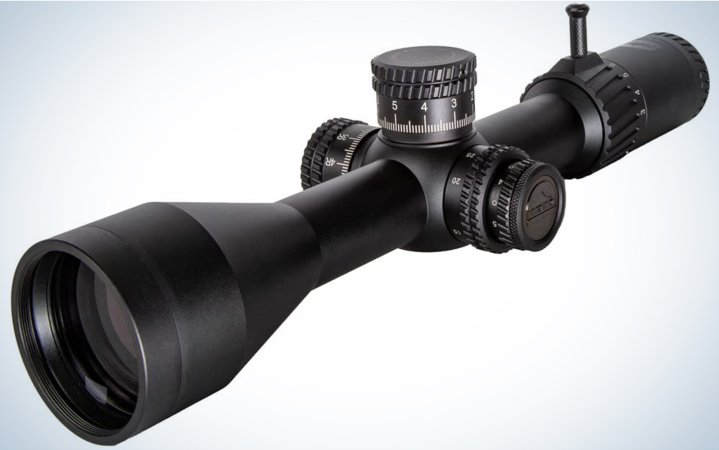
See It
Pros
- First-plane tree-style reticle
- Exposed tactical-style turrets
- Throw lever
- Zero stop
- 6-step illumination
- 25 mils of internal adjustment
Cons
- Disappointing glass
- Ponderously big for hunting
- Limited warranty
Key Features
-
Weight:
30.8 ounces -
Magnification Range:
3-18-power -
Objective Lens Diameter:
50mm -
Tube Diameter:
30mm -
Turret Click Values:
.1 MRAD -
Total Elevation Adjustment:
26 MRAD -
Reticle Focal Plane:
First -
Illuminated Reticle:
Yes
Shooters with a limited budget should give their attention to this full-featured precision scope from Sightmark that retails for around $400. The Presidio has everything that the major brands offer shooters, from a very capable first-plane reticle with plenty of elevation and windage references, oversized exposed turrets to make field adjustments easy, and a zero-stop that allows shooters to return to their zero without tools.
Other noteworthy features for rimfire shooters include a 10-yard-to-infinity focus, 6-step illumination, and reticle holds with 10 MILS of drop and 6 MILS of wind hold. How does Sightmark deliver so much utility for such an accessible price? The glass is flinty and shows lots of optical aberrations. You can expect to get some flaring and peripheral distortion. However, the center of the lens—where most shooters spend most of their time—is clear and sharp. In a field with mostly second-plane, hunting-style scopes, this is a full-featured standout that won’t cost a bunch.

See It
Pros
- Monster magnification range
- Dual-purpose tactical reticle
- Push-button illumination module
- 10 reticle illumination intensity settings
- References for long-distance work
- Pull-to-turn elevation dial
Cons
- Wildly expensive
- 34mm tube is bulky
Key Features
-
Weight:
21.3 ounces -
Magnification Range:
1-10-power -
Objective Lens Diameter:
28mm -
Tube Diameter:
34mm -
Turret Click Values:
.1 MRAD -
Total Elevation Adjustment:
29 MRAD -
Reticle Focal Plane:
First -
Illuminated Reticle:
Yes
The first time I shot this extremely versatile scope it was on a tactical AR and I was engaging targets from 10 yards out to 750 yards. All I could think was how fun it would be on a practical .22 course. This is definitely not intended for NRL22 games, but rather is a battle-hardened tactical optic that has caught fire with personal-defense carbine owners. Still, I maintain the EOTECH Vudu has all the attributes you’d ever want for any rimfire action, whether you’re talking about running rabbits, punching holes in paper targets, or running a steel plate course.
The first-plane reticle evolves from a fast and bright red dot at 1-3-power up to a surprisingly detailed precision reticle with aiming points for distant targets from about 7-power up to 10-power. The illumination is bright, and the push-button control is intuitive. The build and turrets are durable enough for anything you can throw at it, and the Japanese glass is bright and crisp. The main downside is its $1,800 price tag. But at that price, you can switch it to just about any rifle in your collection.
Read Next: Best Budget LPVO

See It
Pros
- Holdover references tuned to .22 WMR
- Objective-bell focus
- Nice illumination
- Good magnification range
- Capped turrets
Cons
- Stingy mounting dimensions
- Reticle utility is limited to WMR
Key Features
-
Weight:
18.1 ounces -
Magnification Range:
4-12-power -
Objective Lens Diameter:
40mm -
Tube Diameter:
1-inch -
Turret Click Values:
.25 MOA -
Total Elevation Adjustment:
80 MOA -
Reticle Focal Plane:
Second -
Illuminated Reticle:
Yes, red and green
If you’re a .22 WMR shooter, this is your scope. The reticle has drops for bullets with muzzle velocities of 2,000 fps. With a 100-yard zero, you can drop rounds with pleasing consistency out to 300 yards with the second-plane BDC reticle and the scope on its highest power. Suppose you want to use a lower magnification, or bullets with different velocities. In that case, you’ll have to experiment on the subtensions, but it’s a pretty handy feature for a rimfire optic. The Hawke has good glass, decent controls, and the illumination is a nice feature. But the attribute that also makes this a great rimfire scope is the focus control located on the objective bell. You can bring targets into focus as close as 10 yards and out to infinity.
Minox RS-4 2.5-10×42
Photo by Andrew McKean 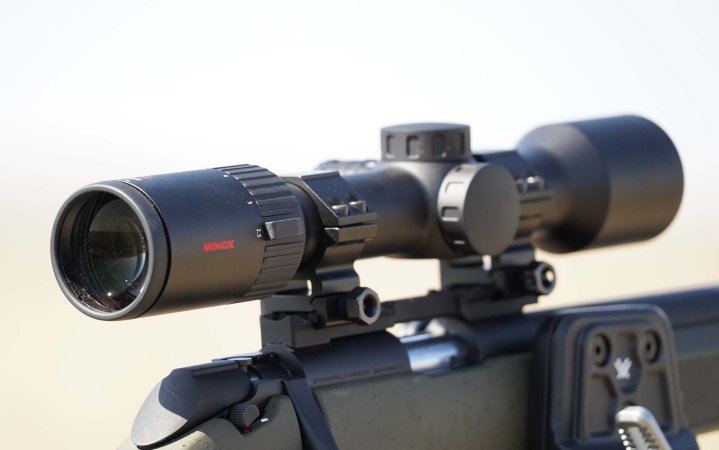
See It
Pros
- Finely illuminated plex reticle
- 11.6-inches long
- Wide field of view
- Liberal mounting dimensions
Cons
- At about $770, an investment
- Reticle limited to close and mid-range shooting
Key Features
-
30mm tube -
Fiber-optic powered center aiming dot -
Second-focal plane duplex reticle -
10-meters-to-infinity side parallax -
10-step center-dot illumination -
Auto shut-off illumination -
Made in Germany
This bright, handy little scope isn’t really intended for rimfires. Instead, it’s designed for dual use, for snap shooting during driven hunts or woodland stalks in the daylight and as a slave scope for thermal clip-ons for nighttime action.
The ultra-short stature of the RS-4 — it’s only 11.6 inches long — and its huge eyebox make this a great deer rifle or straight-wall carbine optic. But all those qualities, plus its big and simple duplex reticle, make it an exceptional rimfire scope. Of course, there are plenty of choices for a .22 at the price of the Minox (around $770). But few scopes bring such elegance, versatility, and sharp handling as the German-made scope.
To be sure, this isn’t a precision rig. It doesn’t have tactical turrets or a stepped-down reticle. It’s solidly a hunting scope, with capped turrets tuned to the traditional European standard of 1-centimeter (at 100 yards) click values. Its 30mm tube has a crazy amount of mounting dimensions, so it should fit a wide range of receivers and action types.
Its side parallax ramps from 10 meters to infinity. And the fiber-optic red dot in the very center of the duplex reticle has 10 steps, from daylight bright to just visible in extremely dark conditions. The auto shut-off feature switches the illumination off after three hours of inactivity.
We employed this scope in our test of thermal clip-ons, where the short length of the Minox put thermal controls in easy reach of the shooter. Plus, the simple duplex is the perfect aiming point for nighttime use, simple, easy to see, and fast to deploy.
My test version of the RS-4 is the 2.5-10×42, which I’d argue is the best all-around configuration for a rimfire, lightweight mountain rifle, or straight-wall carbine, partly because the field of view (16 meters at 100 meters at 2.5x and 4 meters at 10x) is so generous and the image so bright at all magnifications. The scope comes in a 1-4×24, 2.5-10×50, and 3-12×56, the latter iterations optimized for low-light hunting.
GPO Centuri 3-12x44i
GPO 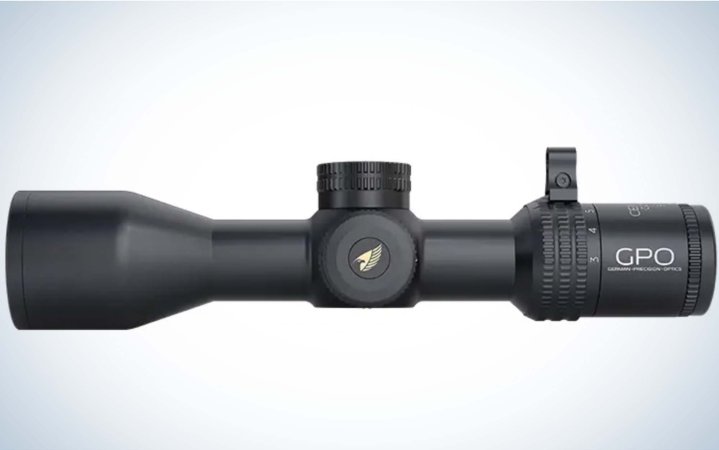
Buy From Amazon
Buy From EuroOptic
Pros
- Good turret tactility
- Short length for use on carbines or as thermal slave scope
- Simple and fast illuminated reticle
- 3.75-inch eye relief
- Fast throw lever on magnification control
- Versatile size for wide range of platforms
Cons
- Given reticle and configuration, doesn’t need parallax control
- Limited mounting dimensions
- Forgettable glass
Key Features
-
30mm tube -
Second-plane illuminated plex reticle -
Fast-focus ocular lens -
Elevation turret zero stop -
18.9-ounce weight -
9.9-inch length -
¼-inch click values -
100-inch elevation and windage adjustment
This compact, versatile scope is mainly intended for use on an AR carbine, or maybe on a bolt gun with a clip-on thermal attached to its objective bell. But don’t overlook its handy configuration for just about any rimfire rifle.
The 30mm scope features an illuminated second-plane “micro-dot” reticle that’s useful for quick target acquisition and close-in work. If you’re interested in a GPO scope that will win Precision Rimfire Series events, you might want to invest in the 3-18×44 Centuri that has a first-plane MOA-based illuminated reticle. But that more advanced scope costs about $660, out of range of most rimfire shooters.
The 3-12×44 Centuri, meanwhile, has appealing features for a wide range of shooters and hunters, including an illuminated center-dot plex reticle for fast target acquisition. The second-plan reticle won’t win many precision target contests, but it’s intended as a fast and versatile scope for close-in work. Given that baseline talent, the adjustable 10-yards-to-infinity parallax control seems a little superfluous, and in the second focal plane, a simple BDC reticle might be a better choice.
Still, the overbuilt Centuri is a good choice for not only field-forward rimfires but also turkey shotguns, slug guns, longer-range muzzleloaders, and just about any AR on the market. Its short 9.9 inches also makes it a perfect slave scope for a clip-on thermal.
At $529, it’s not an inexpensive scope, but it performs a number of tasks well enough that you can trade it between platforms as the season, and the need, dictates.
EOTECH Vudu 3-9×32
Eotech 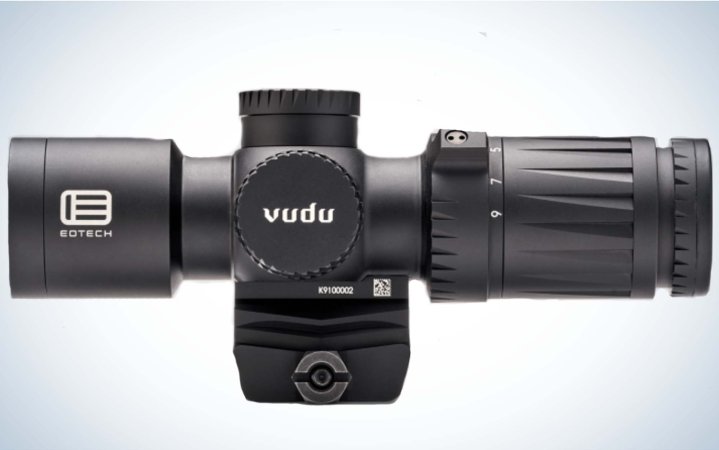
Buy From Optics Planet
Pros
- At 6.8 inches long, one of the most compact magnified scopes on the market
- 30mm tube allows for abundant internal adjustment
- Accepts ring mounts for red-dot sights
- Excellent Japanese glass
- Illuminated second-plane HC1 reticle
Cons
- Very limited mounted dimensions
- Integrated base is not built for precision work
- At over $1,000, not a casual purchase
Key Features
-
30mm tube -
Second-plane reticle -
3-9-power magnification range -
1.56-inch mounting height above bore -
32mm objective lens -
3.1-inch eye relief -
Extremely compact and versatile
This is one crazy scope. The first thing you’ll notice is that it’s only 6.8 inches long, with most of that length devoted to the significant ocular lens and power-changing mechanism. But it’s a fully functional second-plane scope with abundant versatility thanks to its 3-9x zoom range and its excellent turrets.
What’s the perfect use-case for this stubby? It’s configured for close-in AR carbine work, but it’s almost accidentally a really useful rimfire scope, thanks to its excellent glass and durable build. We’d probably recommend this in a 1-6x LPVO configuration, but EOTECH is way ahead of us; if you want close-in point-and-shoot capabilities of an LPVO, just employ its ring mount that accepts non-magnified red-dot sights, including EOTECH’s capable EFLX sights, which can be mounted at 90 degrees on the top of the Vudu or at a 45-degree offset.
What we’re seeing here is an interesting blending of .223/5.56 and .22 LR. We don’t have a test version of this scope to see how it performs on prairie dogs and gophers, but the illuminated HC1 reticle has adequate holdovers and hold-off references for precision work in just about any environment inside 100 yards with rimfires, or 400 yards with center-fire cartridges.
Its Japanese-sourced glass is among the best in this rimfire category, and its controls are positive and extremely repeatable. With 90 MOA of total elevation travel and 60 MOA of total windage travel, there’s plenty of internal adjustment, but in the real world, shooters will rely on reticle references rather than dialing to achieve aiming prescriptions.
Our main complaint is stingy eye relief and very limited mounting dimensions. You’re not going to mount this on a receiver that doesn’t have a Pic rail to allow you to cheat the optic forward or aft to match your own eye relief at various magnifications.
But the super-short build and versatile use-case make this one of the most interesting scopes of the year.
Leupold VX-6HD Gen 2 1-6×24
Leupold 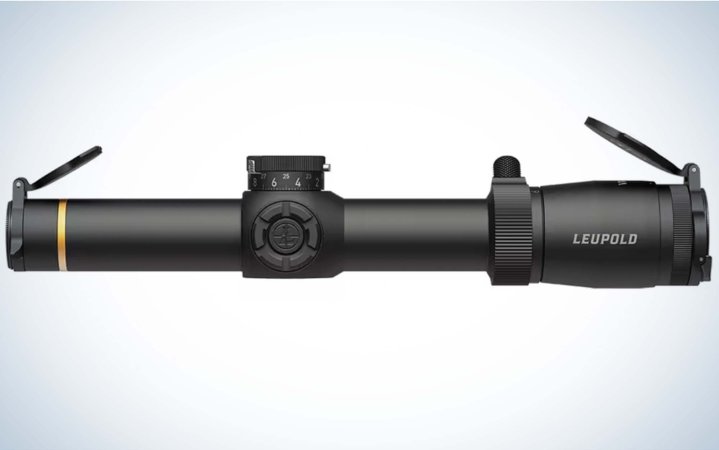
Buy From EuroOptic
Pros
- Excellent glass
- Finely illuminated plex reticle
- Very responsive and repeatable turrets
- Durable build
Cons
- At about $2,000, a pricey rimfire scope
- Limited long-range precision talents
Key Features
-
30mm tube -
Fiber-optic powered center aiming dot -
Second-focal plane reticle -
Fast duplex reticle -
Zero-lock elevation turret -
Precision side focus -
Integrated throw lever -
Electronic reticle leveler -
10.7-inches long
While the new generation of Leupold’s flagship hunting scope is mainly focused on higher-magnification models and big-game uses, this handy LPVO version of the VX-6HD is an awesome varmint and close-in AR carbine scope. It also might be the perfect scope for a straight-wall cartridge hunter.
Like its higher-mag brethren, the 1-6×24 version of the VX-6HD Gen 2 has an overbuilt erector system, which is a fancy term for all the turret works that you can’t see. In LPVO scopes, the erector system is especially sized-down, which puts a premium on precision machining and alignment of moving parts.
In keeping with its fast deployment, the Leupold has a Firedot Duplex illuminated reticle in the second focal plane at its heart. The center illuminated dot is fired by a push-button illumination module and provides a pin-point aiming point inside the plex geometry of the reticle. It’s fast, and given the wide range of illumination useful in full daylight and in very dark conditions.
While the VX-6HD Gen 2 is available in a wide range of configurations, the 1-6x version has a 17-ounce build on a 30mm tube. It has plenty of mounting dimensions and enables both-eyes-open snap shooting and decent precision work. It’s an expensive optic, but its ability to transition from a capable rimfire to a straight-wall carbine to just about any AR platform make it a good investment in a versatile scope.
Things to Consider Before Buying a Rimfire Rifle Scope
Your first consideration if you’re in the market for a rimfire rifle scope is how well it will perform with the short-range capabilities of the caliber. You probably don’t need a ton of magnification or reticle references if all you want is to shoot tin cans or 50-meter bullseye targets. But the world of rimfire shooting is evolving to look a lot like long-distance center-fire precision shooting, with all sorts of precision rimfire competitions and games that put a premium on both short-range and long-range precision. For backyard plinkers, you probably just want a simple scope with a duplex reticle, but for the latter, you’re going to want a first-plane reticle with lots of turret adjustment. Then there are the pure small-game scopes. These are lower-magnification optics with just enough reticle references to get you on game and maybe make longer shots, head-shooting squirrels, for instance.
FAQs
For small-game hunting, I want a scope that gets on target fast, has a reticle that “pops” from the background, but has enough references for me to place bullets precisely out to about 75 or 100 yards. In this collection, the standout hunting scope is Bushnell’s Trophy Quick Acquisition (QA), a 1-6×24 marvel that points quickly, has an illuminated center dot for low-light work, and enough holdover references for longer shots. Others worth a look: Vortex’s Crossfire II, and Tract’s 22 FIRE. At the other end of the spectrum is EOTECH’s expensive 1-10×24 Vudu, which doubles as a marvelous AR optic. Or consider Leupold’s VX-Freedom. Its simple duplex reticle is fast and reliable.
I like lower-power scopes for most rimfire work, whether that’s hunting or target shooting. A 2-7-power or even 1-8-power will give you all the magnification you need for most purposes. But if you’re interested in the precision rimfire competitions, then you’re going to want more magnification to really see the nuances of distant targets. For those times, I’d go with a 5-20-power or 4-16-power range, and make sure that precision target scopes also have manual focus—often called parallax—to bring targets of whatever distance into crisp focus.
The price of rimfire scopes ranges all the way from about $100 up to nearly $2,000. There are problems with both ends of that spectrum, just as there are great deals as long as you know what attributes you want and how you’ll use the scope. Starting at the lower end of the price spectrum, I’d be a little leery of super-cheap scopes, simply because they are probably made with substandard components and may not be as durable as higher-priced models. If you spend under $100 on a scope, make sure it has a good warranty that will cover any breakage or malfunctions.
But you can buy a lot of scope for under $200. Scopes in this roundup include Bushnell’s Trophy QA and Vortex’s Crossfire II, and both the Leupold VX-Freedom and Tract’s 22 FIRE AO are both priced around $300 and offer excellent durability, utility, and warranties. Precision rimfire scopes can be especially expensive, largely because their precision controls and components are built to a higher standard. Still, the Sightmark Presidio, priced under $400, and the Vortex Strike Eagle are both worth looking at for budget precision options. On the other end of the spectrum, both the EOTECH Vudu and Blackhound Emerge offer tons of precision for rimfire shooters, but have all the attributes to transition once you move up to center-fire precision target shooting.
Final Thoughts on the Best Rimfire Scopes
Somehow, the optics industry has squeezed all the fun out of rimfire shooting. Instead of cheap, reliable, and utilitarian rifles, we now have fancy chassis rifles with all the attributes of their big-bore brethren. And prices to match. We’ve complicated what was once the most fun and simple type of shooting into rigorous competition. That’s all great if you want to make .22 shooting into a serious thing, but don’t forget that rimfires are the gateway for most shooters and hunters into our community, and the scopes and rifles that are the best for new shooters are often the most simple and cheap. So read this review with a little bit of skepticism. There are optics for every stage in a shooter’s evolution, but maybe pay special attention to those fun, simple, gateway scopes.
Read the full article here







